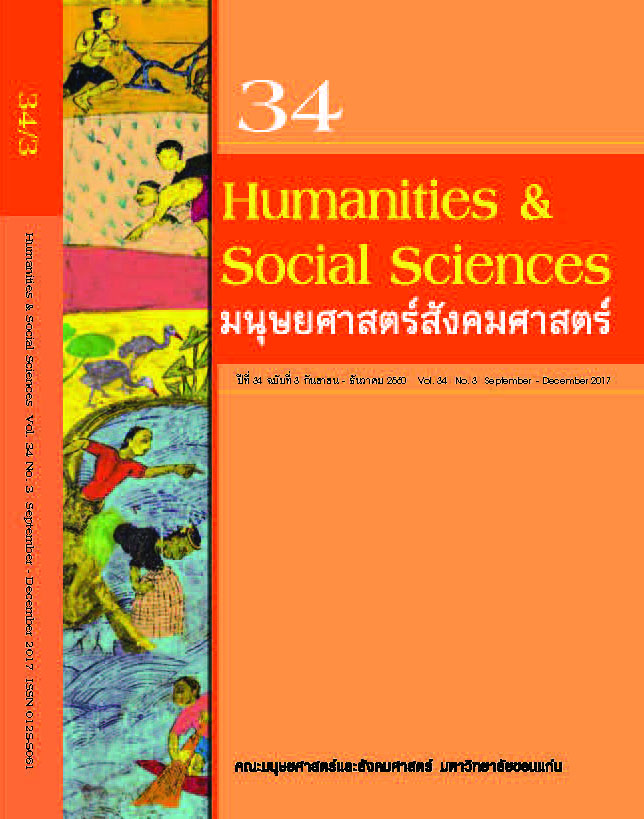พระสงฆ์กับองค์เจ้าในการปฏิรูปหัวเมืองอีสานผ่านกลไกอำนาจรัฐ
Keywords:
บทบาท, พระธรรมยุต, การปฏิรูปหัวเมือง, กลไกอำนาจรัฐ, Role, Dhammayut Monks, Reformation, State ApparatusAbstract
บทคัดย่อ
งานวิจัยนี้เป็นการศึกษาบทบาทของพระสงฆ์ธรรมยุติกนิกายกับพระมหากษัตริย์ในการขับเคลื่อนงานการปฏิรูปหัวเมืองอีสานผ่านการใช้กลไกอำนาจรัฐในระบบสมบูรณาญาสิทธิราช ผู้วิจัย เน้นการเก็บข้อมูลและวิเคราะห์เชิงคุณภาพ โดยอาศัยข้อมูลจากเอกสารเป็นเบื้องต้น และข้อมูลภาคสนามในเขตจังหวัดอุบลราชธานี และจังหวัดสกลนคร จากการสัมภาษณ์กลุ่มตัวอย่างที่เป็นพระสงฆ์และนักวิชาการทางศาสนา ผลการวิจัย พบว่า บทบาทคณะสงฆ์ธรรมยุตอีสานซึ่งถือกำเนิดจากพระวชิรญาณภิกขุ ในรัชสมัยรัชกาลที่ 3 เมื่อพระวชิรญาณภิกขุทรงลาผนวช ขึ้นครองราชย์เป็นรัชกาลที่ 4 พระองค์ได้สร้างแนวร่วมด้วยการดึงเอากลุ่มพระสงฆ์ธรรมยุตอีสานเข้าร่วมขับเคลื่อนนโยบายรัฐเพื่อปฏิรูปหัวเมืองอีสานให้เป็นไทยผ่านบทบาทที่โดดเด่น 4 ด้าน คือ 1) ด้านการศึกษา 2) ด้านศาสนา 3) ด้านสังคมสงเคราะห์ 4) ด้านการเปลี่ยนแปลงสังคมอีสาน แม้บทบาททั้ง 4 ด้านจะได้รับการสนับสนุนจากรัฐชาติ (กษัตริย์) ทั้งงบประมาณและอำนาจ แต่การเคลื่อนไหวของพระสงฆ์ธรรมยุตอีสานเพื่อปฏิรูปทางสังคมและความเชื่อชาวอีสาน นำไปสู่ความขัดแย้งระหว่างพระสงฆ์ธรรมยุตอีสานกับชุมชนและพระสงฆ์ในท้องถิ่น ภายใต้กลไกอำนาจรัฐชาติที่สถาปนาเหนือพื้นที่อีสานทำให้พระสงฆ์ท้องถิ่นอีสานจำเป็นต้องปรับตัวและสร้างอัตลักษณ์ใหม่ภายใต้บริบทรัฐชาติ โดยการทำให้วัดกลายเป็นสถานที่ราชการและพระสงฆ์ที่เป็นพระสังฆาธิการกลายเป็นเจ้าหน้าที่ของรัฐในฐานะเป็นข้าราชการ ในขณะที่การปฏิรูปหัวเมืองอีสานภายใต้การทำงานของพระสงฆ์ธรรมยุตอีสานร่วมกับกษัตริย์ได้สถาปนาอำนาจรัฐเหนือดินแดนอีสานด้วยบทบาทของพระสงฆ์ธรรมยุตอีสาน ทำให้ชุมชนอีสานถูกปรับโฉมหน้าใหม่ให้เชื่อมโยงท้องถิ่นอีสานเข้ารวมศูนย์สู่อำนาจรัฐส่วนกลางในวาทกรรมการพัฒนาแบบสมัยใหม่
Abstract
This research aims to study of the roles of Dhammayut Sangha and the relationship with kings in Northeastern Precints ( Isan), in or der to monitoring the state power in monarchical system during King Rama III and IV periods. This research paid attention an approach on data collection and analysis in qualitative methods. Data Collection has gathered from the primary resources, fieldwork, and interviews within the research areas of Ubonratchathani, and Sakon Nakhon Provinces. The Sampling groups are the monks and scholars who are Buddhism specialties.
The research result found that during the reign of King Rama III, Phra Vachirayana Bhikkhu (later to be King Rama IV) has gathered Isan monks to participate in 4 important parts which are 1. Education, 2. Religion, 3. Social Welfare, and 4 the Social transformation of Isan region. The development of Isan region has been push through the central policies including the financial and power supports. However these movements to transform Isan Social Structure had created the conflict between local people and monks. The new introduction of social transformation has an impact for the Isan monks to adapt and adjust their roles to be a representative of the state. The role of monateric sysmbol transform to be an official administration for the central government, and the monks became the state officers respectively. This phenomenon has shaped and moved Isan Society to adapt themselves to a new pattern of the centralization policy from the central government in the new discourse of modern developments



